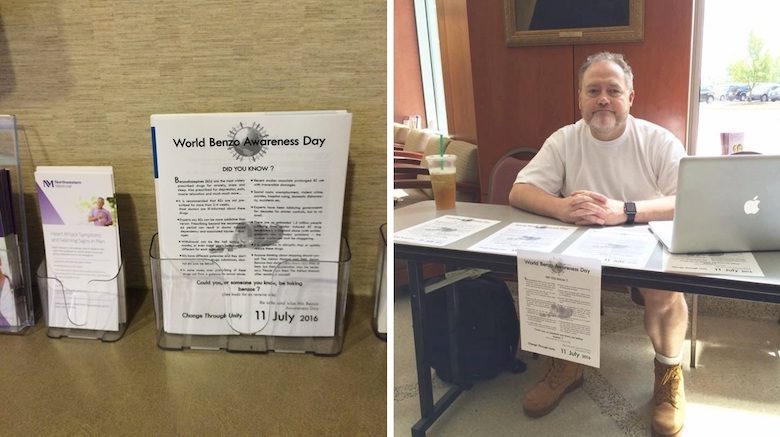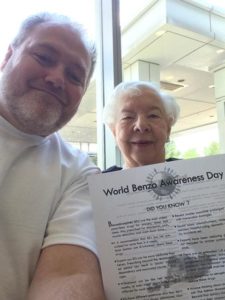Sharing handouts helps educate and save lives.
This page is for educational purposes.
Educating communities on dangers of prescribed benzodiazepines

This page is for educational purposes.
While several of the following downloadable PDFs have been reviewed by a world leading expert on benzodiazepines, the content together with other content that appears on worldbenzoday.org are for informational and discussion purposes only. They are to assist in awareness and education. They are not intended to be a substitute for medical advice. They are not intended to treat, cure or diagnose any disease. Do not make changes or stop your medication without consulting a qualified professional.
On this page you will find:
Click here to view and save .PDF (8.5″ x 11″ standard printer paper)
This handout can help someone understand Benzodiazepine Withdrawal Syndrome (BWS) and its associated longer-lasting illness, Protracted Withdrawal Syndrome (also known as Post-Acute Withdrawal Syndrome) associated with potential neuronal damage from BZDs.
The information was reviewed by Professor Malcolm H. Lader, O.B.E., LL.B., D.Sc., Ph.D., M.D., F.R.C. Psych., F. Med. Sci., a world-renowned expert on benzodiazepines and former advisor to the World Health Organization. Information from Professor C. Heather Ashton is also included regarding the possibility of structural neuronal damage. The information in this handout is intended for informational and discussion purposes only.
Click here to view and save .PDF (8.5″ x 11″ standard printer paper).
This one page, one-sided handout provides 10 facts to quickly educate any recipient about the sordid history of the benzodiazepine drug class, controversy on statistics, how long-term studies and RCTs weren’t adequately conducted, BZDs and the elderly, prescribing guideline controversy, etc. Special thanks to W-BAD representative, Sonja, for contributing this handout and for her research.
Click here to view and save .PDF (8.5″ x 11″ standard printer paper).
This two-page handout provides information and statistics about benzodiazepines and nonbenzodiazepines (“Z-drugs”) in general and, more specifically, around their combination with opiates and other medications. Currently, opioid legislation is popping up across the United States and sometimes benzodiazepines are being “lumped in” with these guidelines. This is concerning and dangerous because there is much ignorance around and mostly no consideration given to the unique withdrawal protocol required for discontinuing the benzodiazepine and “Z-drug” classes. This handout was designed to educate about this problem and will be distributed at opiate summits as well as shared with D.A.R.E. police officers and legislators, etc. Special thanks to W-BAD supporter, Kiesha, for contributing this handout.

Click here to view and save .PDF (5″ x7″ – please choose “fit to paper” when printing on standard 8.5″ x 11″ printer paper)
This printable .PDF file can help make a professional, such as a prescriber, aware of benzodiazepine associated illness and withdrawal.
The text on this handout was reviewed and endorsed by Professor Malcolm H. Lader, O.B.E., LL.B., D.Sc., Ph.D., M.D., F.R.C. Psych., F. Med. Sci. Professor Lader is a world renowned expert on benzodiazepines and former advisor to the World Health Organization. The information on this handout is intended for informational and discussion purposes only.

Click here to view and save .PDF (5″ x7″ – please choose “fit to paper” when printing on standard 8.5″ x 11″ printer paper)
This printable .PDF can help make a social worker, counselor or therapist aware of what is happening to a client experiencing benzodiazepine associated illness and withdrawal.
Because therapists help their clients cope with a variety of problems, it is important for them to be aware of a central nervous system that is in a medication withdrawal-induced (physiologic) hypersensitive state.
The text on this handout was reviewed and endorsed by Baylissa Frederick of Bloom in Wellness, a qualified therapist with a specialty in coaching people through benzodiazepine withdrawal syndrome. Additionally, Baylissa has suffered from benzodiazepine withdrawal syndrome and has the first-hand experience with it, which is why her practice includes sufferers of benzodiazepine (and other psychotropic drugs) withdrawal.
Click here to view and save .PDF (5″ x7″ – please choose “fit to paper” when printing on standard 8.5″ x 11″ printer paper)
This printable .PDF can help support the loved ones, caregivers, friends and family members. It can help them understand what is happening to their loved one. Often, these supporters are also affected by their loved one’s suffering. However, they play a critical role in the sufferer’s process of tapering and withdrawal.
Info for nursing and skilled care homes

Click here to view and save .PDF (5″ x7″ – please choose “fit to paper” when printing on standard 8.5″ x 11″ printer paper)
This printable .PDF file details what you should know if an elderly person is newly prescribed or already taking a benzodiazepine. It can help make a professional, such as a prescriber, nursing, and skilled care home workers, or family members of an elderly person aware of benzodiazepine associated problems in the elderly. It is intended to both educate and aid anyone who lacks awareness in recognizing and handling the care of an elderly person who is already taking benzodiazepines or who has newly been prescribed one.
The text on this handout was reviewed by Professor Malcolm H. Lader, O.B.E., LL.B., D.Sc., Ph.D., M.D., F.R.C. Psych., F. Med. Sci. Professor Lader is a world renowned expert on benzodiazepines and former advisor to the World Health Organization. The information on this handout is intended for informational and discussion purposes only.